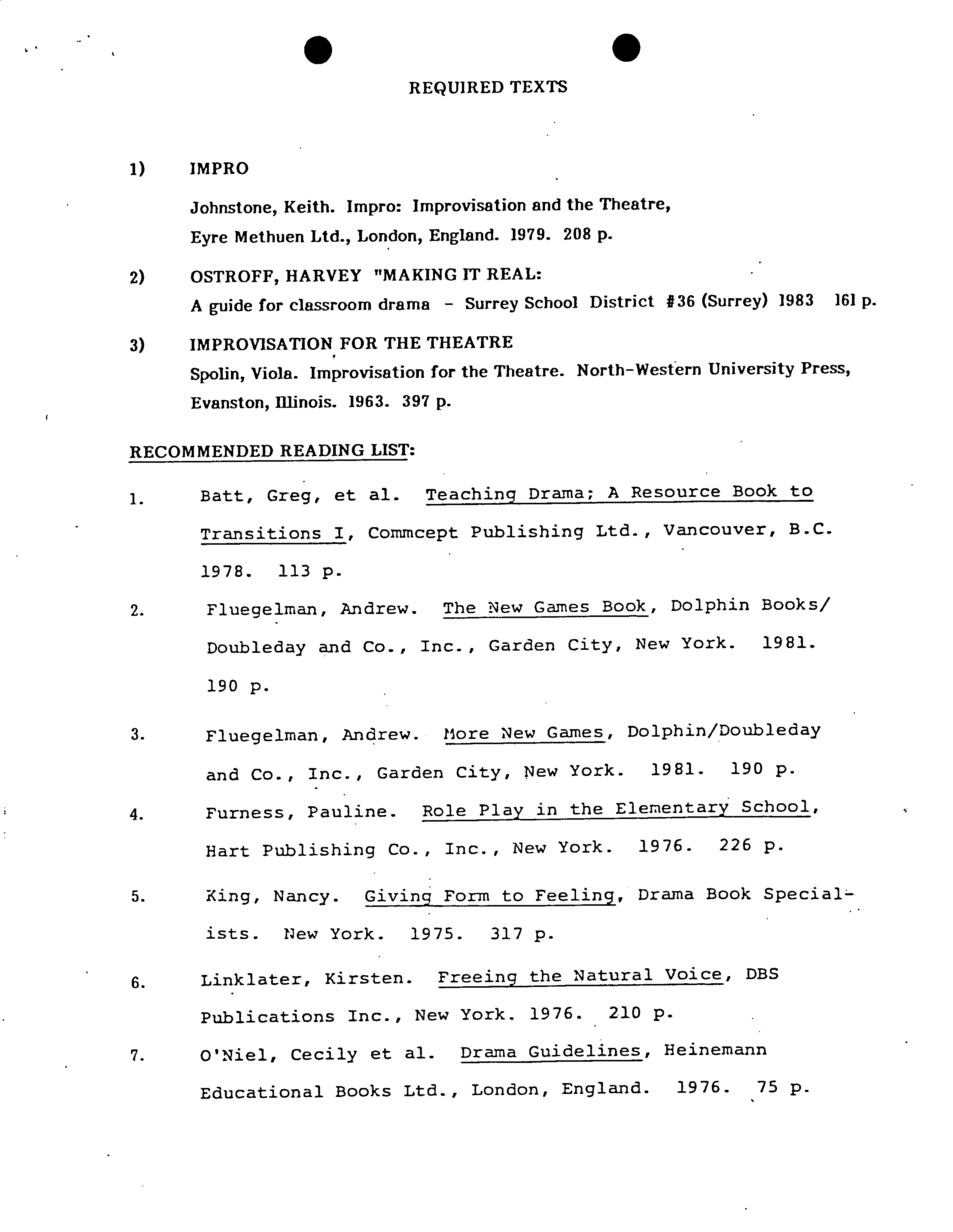EDUCATION 487-4
DRAMA IN THE CLASS1)OM
?
S
INTERSESSION; 1984
?
INSTRUCTOR: Harvey Ostroff
IvDNDAY E
1
WEDNESDAY, 5:30 - 9:20
?
LOCATION: ?
On Campus
OBJECTIVES:
This course will examine the techniques of Developmental Drama and its
uses as:
a)
A TEACHING STRATEGY
b)
A CATALYST TO INDUCE A POSITIVE CLASSROOM ATMOSPHERE
c)
A CREATIVE APPROACH TOWARDS ONES OWN TEACHING STYLE
In a sequential mode, students will engage in a variety of exercises that
will culminate with student designed lessons on various areas of the core curriculum.
By following a programme developed to encourage group trust and positive action,
students will gradually build upon their own confidence and abilities and therefore
need not be concerned about a lack of previous experience
in
this field.
OUTLINE-OF TOPICS
The sequence to be followed includes:
1) CLASSROOM MANAGEMENT: Programme set-up, theatre
games, warm ups.
2)
PREPARATION:
3)
GROUP DYNAMICS:
4)
PHYSICAL ACTING:
5)
THE ORAL/AURAL MODE:
6)
THE UNSCRIPTED ROLE:
Concentration, guided imagery,
the creative process.
Co-operation, trust exercises.
Movement, mime, mask,
c haracterization.
Articulation, vocal variety & energy
listening skills, story drama.
Improvisation, role play, role drama.
7)
DRAMA AS A METHODOLOGY: Application of creative process
to curricula.
8)
PROJECT WORK:
?
Playmaking, docudrama, creative
movement (student designed)
TYPICAL REQUIREMENTS:
Students will be required to participate in workshop activities
- complete a journal of observation and research.
- design and present a curriculum based project
- adapt or create one or more theatre games
- participate in discussions based on a) the reading
list, b) the work in progress.
ELIGIBILITY:
This course would be applicable to both Education and 'Theatre Arts Students.
.
REQUIRED TEXTS
1)
IMPRO
Johnstone, Keith. Impro: Improvisation and the Theatre,
Eyre Methuen Ltd., London, England. 1979. 208 p.
2)
OSTROFF, HARVEY "MAKING IT REAL:
A
guide for classroom drama - Surrey School District #36 (Surrey) 1983 161 p.
3)
IMPROVISATION FOR THE THEATRE
Spolin, Viola. Improvisation for the Theatre. North-Western University
Press,
Evanston, Illinois. 1963. 397 p.
RECOMMENDED READING LIST:
1.
Batt, Greg, et al. Teaching Drama; A Resource Book to
Transitions I, Cornrncept Publishing Ltd., Vancouver, B.C.
1978. 113 p.
2.
Fluegelrnan, Andrew. The New Games Book, Dolphin Books!
Doubleday and Co., Inc., Garden City, New York. 1981.
190 P.
3.
Fluegelman, Andrew. rore New Gaines, Dolphin/Doubleday
and Co., Inc., Garden City, New York. 1981. 190 P.
4.
Furness, Pauline. Role Play in the Elementary School,
Hart Publishing Co., Inc., New York. 1976. 226 p.
5.
King, Nancy. Giving Form to Feeling, Drama Book Special-
ists. New York. 1975. 317 p.
6.
Linklater, Kirsten. Freeing the Natural Voice, DBS
Publications Inc., New York. 1976. 210 p.
7.
O'Niel, Cecily et al. Drama Guidelines, Heinemann
Educational Books Ltd., London, England. 1976. 75 p.
Recommended Re8dinist (ConUd)
8.
Shepard, Richmond. Mime: The Technique of Silence,
DBS Publications Inc., New York. 1971. 142 p.
9.
Wagner, Betty Jane. Dorothy Heathcote:. Drama as a
Learning Medium, National Education Association,
Washington, D.C. 1976. 238 p.
10.
Way, Brian. Development Through Drama, Longman Press,
London, England. 1967.
'
308 p.



